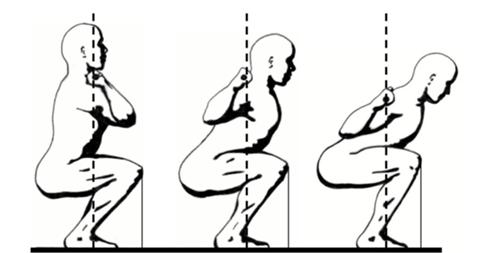The powerlifting squat, or power squat for short, is the squat variation as performed by powerlifters. Unlike the conventional barbell squat, the power squat primarily targets your glutes and not your quadriceps.
A FUNDAMENTALLY DIFFERENT WAY OF SQUATTING
The squat is one of the three parts of powerlifting and it is necessary to squat to ‘only’ parallel. That is, until your thighs are parallel to the floor. Deeper squats make the lift harder – why make it harder on yourself in a competition?
However, the power squat (also known as low-bar squat or sumo squat) is not just a conventional squat (also called Olympic squat) performed with a limited range of motion (ROM). It’s a fundamentally different way of squatting, which puts a greater strain on your hips, and ‘degrades’ your quadriceps – the actual target muscle in squats – to an auxiliary muscle.
Do you want to lift as much weight as possible? Then make sure you master the power squat. Do you mainly squat for stronger and bigger quadriceps? Then do the conventional squat. In practice, of course, nothing stands in the way of doing both exercises.
EXECUTION
You start the power squat in a different starting position than the conventional squat. The bar rests on your back shoulder heads rather than on top of your traps and your feet are slightly wider than shoulder-width apart – approximately level with the outer rings on the barbell. Due to the lower placement of the bar on your back, your hands are slightly further out than with the regular squat. Or you grab the bar a little wider.
 Squat styles: the high-bar squat (center) and the low-bar squat (right). Left the front squat. Note that the bar placement is aligned with the center of the foot on all three posts.
Squat styles: the high-bar squat (center) and the low-bar squat (right). Left the front squat. Note that the bar placement is aligned with the center of the foot on all three posts.The downward movement is initiated by bending the hips. Instead of focusing on the knee bend, sit back, as if trying to sit on a chair that is a little too far away from you. To keep the bar above the center of gravity and balance, your torso tilts forward at an angle. Because your hips move so far back on the power squat, your knees don’t move past your toes and your shins are almost perpendicular to the floor.
Squat until your hips are a fraction past your knees (you should be able to use a spirit level on your thighs) and now come back up by extending hips and knees. With the power squat you generate the power from your hips and not from your thighs. In that sense, the power squat is very similar to the so-called back lift, which allows you to move huge weights.
In the video below the differences between the conventional (Olympic) and power squat. You usually see bodybuilders and actually the majority of gym visitors doing the conventional squat, but usually a little more diagonally. In fact, a hybrid squat.
FINALLY
In some ways, the power squat is a less natural move than the conventional squat. It takes some time to master the exercise. The box squat is an exercise that can help you with this. The power squat can also confront you with relative weaknesses, especially in your hips. Don’t worry: you have plenty of auxiliary exercises for that, such as the pull-through, glute bridge and hip raise .